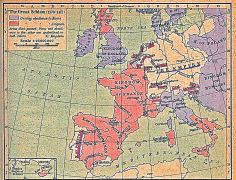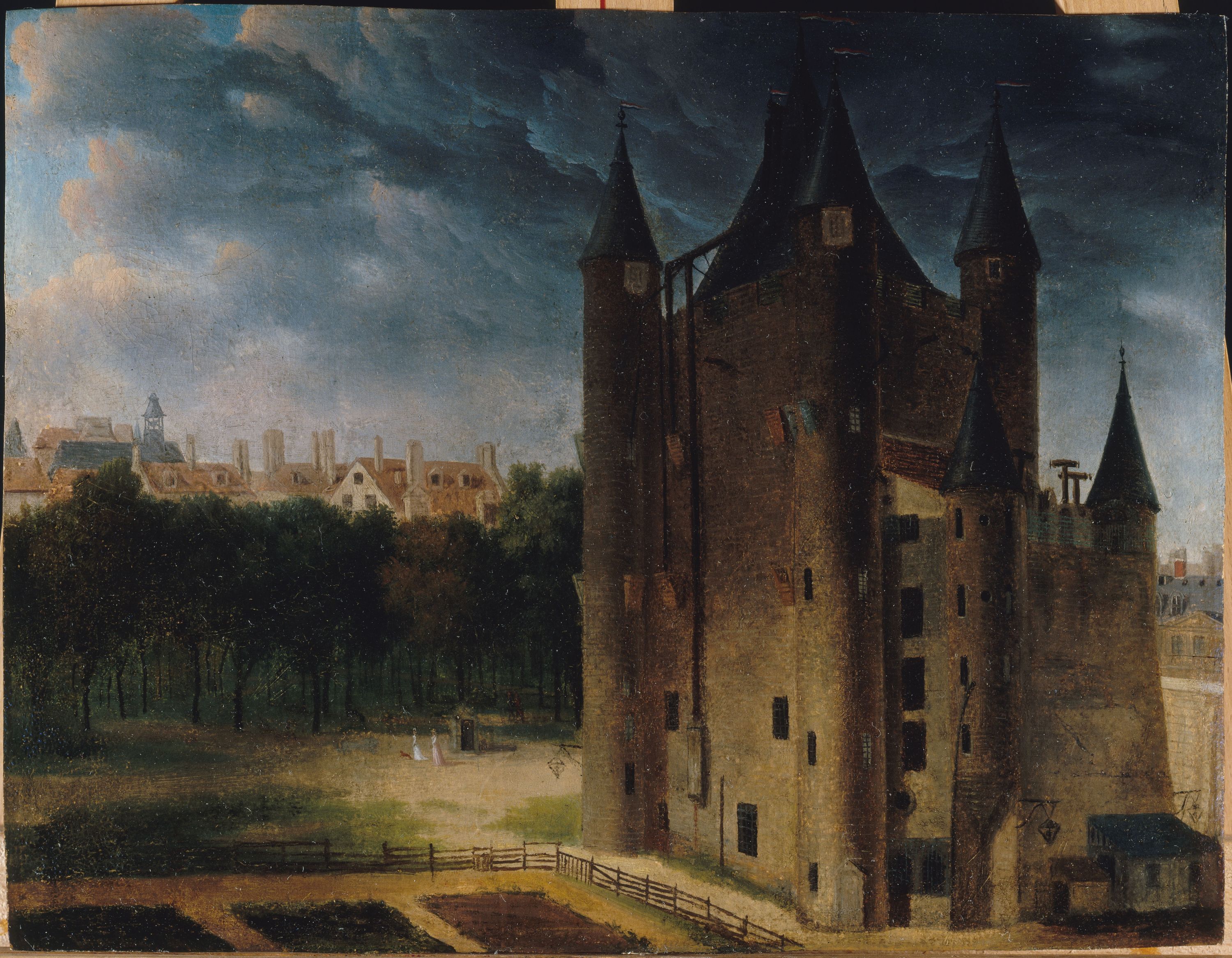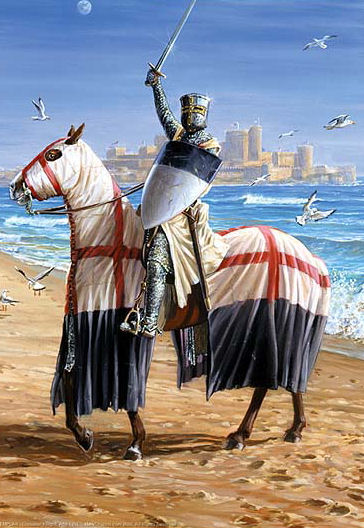A guide to brilliant history, from Caesars to Czars and everything in between.
Welcome to Your Historical Compass
"The purpose of this blog is to generate discussions about historical issues. Students, enthusiasts, and friends are all welcome to join by reading and participating with comments. I hope to generate interest in history and offer help to the perplexed." Caleb Johnson
Monday, October 31, 2011
All Saints Eve
On October 31, 1517 AD, Martin Luther nailed his 95 theses on the doors of the cathedral in Wittenburg. The theses would not have been alone, for many people posted notices on the doors. Yet, these theses stood out in one major respect, because they criticised the Holy Mother Church.
Among the many abuses listed in the theses was the sale of indulgences by church officials. Indulgences were sold to people on the basis that they could buy years out of purgatory. John Tetzel, a Dominican cleric, had launched an indulgence campaign to help pay for the building of St Peter's Church in Rome. Luther started writing criticism, not only of Tetzel, but of the many extra-Biblical practices of the church. For his criticism, Luther was summoned to Rome to answer to the inquisition. However, Fredrick, Duke of Saxony, refused to let Luther be tried outside Germany and even got Luther a promise of safe conduct to the new hearing location, Worms. At Worms, Luther was asked if he would recant his writings and works. Luther refused and after explaining why said, "Here I stand, so help me God."
Luther was condemned as a heretic, but it was too late. The printing press had distributed his work and he gained much popular support. Luther advocated the printing of the Bible in German and set to translating it himself. Meanwhile, Emperor Charles V had summoned the German princes to Augsburg to unite against Luther and suppress his teachings. The princes, however, stood up to their emperor. There they confessed their faith and refused to suppress the new teachings of the protesters, now called "Protestants." The movement grew, fueled by the media and printing press; it spread to England, Holland, Sweden, and assorted parts of Germany.
Luther is responsible in many ways for the break with the Catholic Church and the beginning of the Protestant Reformation. Others would follow, but Luther's cause and resolute determination helped reintroduce Christ and the Bible to Christians everywhere.
Tuesday, October 25, 2011
Temporary Absence
Dear readers,
Due to the demands of my family's current schedule, I have suspended my posts for this week. I plan to have an irregular article posted in time for Reformation Day, or October 31st. This post will feature Martin Luther and the beginnings of the Protestant Reformation.
I hope I can give you all an inspiring read,
on this year's night of Hallows Eve!
Dear readers,
Due to the demands of my family's current schedule, I have suspended my posts for this week. I plan to have an irregular article posted in time for Reformation Day, or October 31st. This post will feature Martin Luther and the beginnings of the Protestant Reformation.
I hope I can give you all an inspiring read,
on this year's night of Hallows Eve!
Sunday, October 23, 2011
The Three Estates Pt. 2
 |
| Boniface VIII and Cardinals |
In the Middle Ages, the only institution that held more sway over the common people than the nobility did was the church. As it was the ordained arbiter between God and an ignorant flock, the church not only held spiritual power, but political, as well. Kings were crowned by bishops and emperors by popes. The church also wielded what was called the double-edged sword. In effect, this idea meant that the church was a check on secular power. Excommunication was the main force of the pope's temporal power. By excommunication, the pope denied the targeted sovereign the right to rule and encouraged other kings to seize his lands. Not only were the pope and his clergy powerful, but they were also rich. Its members constituted 2% of the population, but they controlled 30% of the land and wealth. Inevitably, this led to abuse and the pursuit of clerical office merely for money. As though this were not bad enough for the lay people, worse was yet to come.
 |
| Political split between the two Papal factions |
In 1378 two rival popes claimed the Papacy, dividing the Catholic Church in two. Both simultaneously excommunicated each other and their respective flocks. This meant that everyone in medieval Europe at this time was under excommunication from one pope or the other. While the two factions fought it out for 39 years, the common people were left to doubt and worry. They were uncertain that their child could really be baptized by an excommunicated clergy, or that last rites and burial would save them from eternal damnation. In this way the church lost the faith of the French people. Although the schism was healed in 1417 and the church was able to regain some sense of legitimacy, deep currents of discontent were brewing that would come to a head in the late 18th century.
Wednesday, October 19, 2011
Purple, the Royal Color
 |
 |
| Bolinus Bandaris |
 |
| Tyrian Purple |
Saturday, October 15, 2011
Templars Pt. 3
The fall-
1307 A.D.
The French King, Phillip IV the fair, has run out of money. His wars with Flanders and other principalities have emptied the treasury. Phillip went to great lengths to acquire funds where ever he could. In 1306, he expelled the Jews and seized their property. He even taxed the clergy, an unprecedented move that eventually claimed the life of the Pope. Yet the King's finances had not improved. Desperate, Phillip decided to come down on one of the richest institutions of the day, the order of the Knights Templar.
The Templars were easy enough targets. They held secret meetings, answered only to the Pope, and grown rich from their banking industry. Many contemporary chroniclers accuse them of greed and avarice. For Phillip, it seemed all to easy. He set to work trumping up charges of heresy, sorcery, perversion, and demon worship. It would appear that the Templars got wind of the plot because on September 7, 1307, a convoy left the Templar house in Paris and made its way to La Rochelle. There the convoy met up with the Templar fleet. Once the cargo had been loaded, the fleet disappeared and was never seen again.
On Friday the 13th, the original black Friday, the King acquired an excommunication for the Templars from the Pope, and the arrest warrants went out. In the country side, Templar holdings were seized without resistance as there were no warriors but stewards there. In Paris however, the Temple was well armed. The Kings men lay siege to the great castle inside the city and it eventually fell. The grandmaster of the order, Jacques deMolay, was arrested and imprisoned. During the forthcoming inquisition, the Templars were tortured and coerced to confess to their charges. Many confessed and were released, going on to join the Hospitalers, or Teutonic knights (two other military orders). But a few recanted their confessions were burned at the stake. At his execution, Jacques deMolay cursed the Pope and the French dynasty, saying he would meet the Pope and King within a year to answer to God. As predicted, both Phillip and the Pope died within a year.
But what of the Templar treasure? The kings men found nothing but documents and coded messages in the Templar house. No gold, no silver, nothing. In sum, the most money was made from the Templar lands the crown seized. Popular speculation suggests that the fleet that left La Rochelle six days before the arrests took the treasure to Scotland. There, the excommunicated King Robert the Bruce would have given them sanctuary as fellow excommunicates. Though none of this has been proven, it remains a possibility. Other stories have sprung up about the Templars as well. Of how they found the philosopher stone, the diary of Christ, or the most popular, the Holy Grail. Whether they found the Holy Grail, practiced heresy, or were unjustly accused because of their wealth, they make great subject for study. Although the myriad of theories about the Knights Templar are captivating, this author recommends that in the end they are disappointing. The historical record is the best source of information about this great order.
1307 A.D.
The French King, Phillip IV the fair, has run out of money. His wars with Flanders and other principalities have emptied the treasury. Phillip went to great lengths to acquire funds where ever he could. In 1306, he expelled the Jews and seized their property. He even taxed the clergy, an unprecedented move that eventually claimed the life of the Pope. Yet the King's finances had not improved. Desperate, Phillip decided to come down on one of the richest institutions of the day, the order of the Knights Templar.
The Templars were easy enough targets. They held secret meetings, answered only to the Pope, and grown rich from their banking industry. Many contemporary chroniclers accuse them of greed and avarice. For Phillip, it seemed all to easy. He set to work trumping up charges of heresy, sorcery, perversion, and demon worship. It would appear that the Templars got wind of the plot because on September 7, 1307, a convoy left the Templar house in Paris and made its way to La Rochelle. There the convoy met up with the Templar fleet. Once the cargo had been loaded, the fleet disappeared and was never seen again.
 |
| The Temple in Paris |
 |
| Jacques deMolay's execution |
But what of the Templar treasure? The kings men found nothing but documents and coded messages in the Templar house. No gold, no silver, nothing. In sum, the most money was made from the Templar lands the crown seized. Popular speculation suggests that the fleet that left La Rochelle six days before the arrests took the treasure to Scotland. There, the excommunicated King Robert the Bruce would have given them sanctuary as fellow excommunicates. Though none of this has been proven, it remains a possibility. Other stories have sprung up about the Templars as well. Of how they found the philosopher stone, the diary of Christ, or the most popular, the Holy Grail. Whether they found the Holy Grail, practiced heresy, or were unjustly accused because of their wealth, they make great subject for study. Although the myriad of theories about the Knights Templar are captivating, this author recommends that in the end they are disappointing. The historical record is the best source of information about this great order.
Wednesday, October 12, 2011
Christopher Columbus
It is recommended that you listen to the music at the attached link while reading this post. Enjoy! http://grooveshark.com/#/s/1492+Conquest+Of+Paradise/3SKWoa?src=5
During the Middle Ages, the Byzantine city of Constantinople controlled the spice trade from east to west. In the year 1453, Constantinople fell to the Ottoman Turks. The Ottomans then went on to conquer Alexandria, effectively cutting off all Europe from the East Indies and their spices. This left many in Europe in want of the basic spices that they had come to enjoy. Medieval beef was no good without pepper to cover up the rotten odor. In the years between 1453 and 1492, the Portuguese found a way around Africa to get to India. This was great for the Portuguese who could monopolise the spice trade, but the rest of Europe wanted competition. It is for this reason that Columbus planned to under-cut the Portuguese and find his own way to the Indies.
So off he went in his three ships: La Nina, La Pinta, y La Santa Maria. Picture for a moment, if you will, the fate of the billions of souls to come that rested on those three small ships striking their way across the Atlantic Ocean. How amazing it is that history can be changed by so few men. I won't ask you to imagine what the world would be like if 1492 didn't happen, but try to appreciate that it did happen and that is why we are here now in America. Columbus might not have technically "discovered" America, but he was the first one to tell everybody that he did. That is why we remember Columbus instead of the others that came before him.
Saturday, October 8, 2011
Templars Pt. 2
The turning point-
1187 A.D. The peace between the crusader states and Saladin had collapsed due to the marauding acts of a renegade knight, Reinald de Chatillon. Reinald had captured a caravan with Saladin's sister, whom he killed. In response, Saladin mustered the combined strength of Syria, Iraq, and Egypt to drive out the crusaders and recapture Jerusalem. King Guy de Lusignan also mustered the strength of the kingdom, including the Templar forces. At the battle of Hattin, Saladin drew the crusader army out into the desert and peppered them with arrows until there was nothing left. The king, the grand master of the Templars, and Reinald de Chatillon were captured. Saladin spared the life of the king, but killed Reinald and the grand master. The captured Templars suffered a universal fate, as Saladin knew they would always return to fight him. Saladin then went on to capture Jerusalem. All but a few coastal cities remained of the crusader states as they waited for reinforcements. By now, the Pope had called a new crusade.
The Third Crusade, or King's Crusade, led by Richard the Lion Hearted, dealt Saladin several blows, but failed to reach its ultimate objective, the recapture of Jerusalem. The Templars, now deprived of their headquarters, set to work promoting crusader fervor back in Europe. However, as the years went on, the repeated attempts to recapture the Holy City failed and people began to wonder why they should give their money to a lost cause.
One place the people were interested in giving their money was the Templar pilgrim fund. In a way, the Templars invented our modern banking system. Pilgrimage was a dangerous undertaking and the road was fraught with robbers. Pilgrims needed someone they could trust to keep their money safe. Being the strongest institution around, the Templars had the arms and material to transport gold and silver. However, the Templars decided there must be a more efficient way than shipping the gold all around Europe. They invented a deposit system where a pilgrim could deposit their funds at a Templar house in Europe and receive an encoded check with an account number and amount. The pilgrim would then go to the Holy Land and present their check to the Templar house in one of the crusader cities. A Templar clerk would then decode the check using a certain machine, the details of which were lost to posterity, locate the account, withdraw the money from the vault and give the money to the pilgrim for a small fee. In this way, the Templars accumulated great wealth and the envy of the kings of Europe. In the next and last installment, we'll see how the Templars fell from grace and into myth and legend.
 |
| Templars surrounded at Hattin |
The Third Crusade, or King's Crusade, led by Richard the Lion Hearted, dealt Saladin several blows, but failed to reach its ultimate objective, the recapture of Jerusalem. The Templars, now deprived of their headquarters, set to work promoting crusader fervor back in Europe. However, as the years went on, the repeated attempts to recapture the Holy City failed and people began to wonder why they should give their money to a lost cause.
 |
| Pilgrims depositing funds at a Templar house |
Wednesday, October 5, 2011
The Three Estates Pt. 1
During the Middle Ages, France was the centre of the continent. It far surpassed its neighbors in population, culture, strength of arms, and power. Its cities held the tallest cathedrals, its kings and nobles lead most of the crusades, and its clerics were second only to the Italians in ecclesiastical matters. Back then, French society was divided into what we now call the Three Estates.
The first Estate was the nobility, or Chevaliers (knights). They owned most of the land in France and all the revenues thereof went to their benefit. They were the ones who answered the king's call to war, though often they rebelled against him. Their castles dominated the landscape, except for the towns which defiantly maintained their autonomy. In the south of France, ideas about courtly love, poetry, and manners sprang up. These ideas came together to become what we now call chivalry. However, chivalry became more of an idyllic, rather than a practical, way of life. Vanity, licentiousness, avarice and vice dominated the First Estate. The lofty code of chivalry was all right to display at tournaments when everyone was looking, but for the everyday, it was considered too inconvenient.
The First Estate, while touting their chivalry and way of life, often oppressed the peasantry. With no representation, education, or means of communication, the peasantry was easily isolated and subjugated. In this way the First Estate lost the faith of the people of France. Though the First Estate was able to keep their hold on society for a long time, that time was soon to come to an end.
 |
| A knight and lady |
The First Estate, while touting their chivalry and way of life, often oppressed the peasantry. With no representation, education, or means of communication, the peasantry was easily isolated and subjugated. In this way the First Estate lost the faith of the people of France. Though the First Estate was able to keep their hold on society for a long time, that time was soon to come to an end.
Saturday, October 1, 2011
Templars Pt. 1
Whether you've seen them in National Treasure, The DaVinci Code, or one of the many other popular books and articles featuring them, the Templars have caught the popular imagination. But strip away all the mystery, symbols, rumors, and legends and what do we really have? Who were these warriors in white and red whose legacy has endured the test of time? In this three-part series, we'll look into this ancient order and try to separate fact from fiction.
-The Beginnings
When crusader forces captured and sacked Jerusalem in 1099, they ushered in a new era in the Holy Land, or Outremer as they called it. Among the many needs of the newly found kingdom was Christian manpower. Heavily out-populated by their subjects, the Christian kings of Jerusalem pleaded with the Pope and the other magnates of Europe for reinforcements to strengthen their tenuous position. Not only were knights needed to protect the borders from hostile neighbors, but also to aid the pilgrims that flooded the land after its capture. In an attempt to solve said problems, one knight, Hugh de Payns, petitioned King Baldwin II to allow him to form a new monastic order. Baldwin granted Hugh his request and gave his order the Al-Aqsa Mosque in Jerusalem. Since the mosque was on the Temple Mount, they were given the name "Knights of the Temple of King Solomon" or Knights Templar. The order started out with just nine knights who patrolled the pilgrim roads and aided the poor and the helpless. However, nine knights were not enough for a man of Hugh's vision, so he set out for Rome to promote his new order.
After Hugh received the blessing of Pope Honorious II in 1129, the order enjoyed the good press of one of the most influential clerics of the time, Bernard de Clairvaux. Clairvaux was influential in promoting the order to the rest of Europe, and soon the Templars were blessed with great patronage. Manors were donated, properties entrusted, and nobles' sons, deprived of the hope of inheritance, flocked to the new monastic warrior group. Soon the Templars had control of many lands and properties around Europe, the revenues of which were used by the order for the defence of the Holy Land. In Jerusalem the order built castles and hospitals, giving a shot in the arm to the fledgling kingdom. The pride of the military force of the kingdom was the crack troops of the order of the temple.
For many years the Templars aided in the success of the Kingdom of Jerusalem, but on the horizon storm clouds were forming. In a dizzying string of events, Saladin, the sultan of Egypt, brought Syria and Iraq under his control and the crusader states were surrounded. A tenuous peace was maintained with Saladin while the leper king Baldwin IV was alive. When Baldwin died, his sister, Sibylla and her husband Guy deLusignan ascended the throne. Unfortunately for the peace, Guy was unable to control his war-mongering friends and Saladin declared war.
-The Beginnings
 |
| Hugh de Payns |
After Hugh received the blessing of Pope Honorious II in 1129, the order enjoyed the good press of one of the most influential clerics of the time, Bernard de Clairvaux. Clairvaux was influential in promoting the order to the rest of Europe, and soon the Templars were blessed with great patronage. Manors were donated, properties entrusted, and nobles' sons, deprived of the hope of inheritance, flocked to the new monastic warrior group. Soon the Templars had control of many lands and properties around Europe, the revenues of which were used by the order for the defence of the Holy Land. In Jerusalem the order built castles and hospitals, giving a shot in the arm to the fledgling kingdom. The pride of the military force of the kingdom was the crack troops of the order of the temple.
For many years the Templars aided in the success of the Kingdom of Jerusalem, but on the horizon storm clouds were forming. In a dizzying string of events, Saladin, the sultan of Egypt, brought Syria and Iraq under his control and the crusader states were surrounded. A tenuous peace was maintained with Saladin while the leper king Baldwin IV was alive. When Baldwin died, his sister, Sibylla and her husband Guy deLusignan ascended the throne. Unfortunately for the peace, Guy was unable to control his war-mongering friends and Saladin declared war.
Subscribe to:
Posts (Atom)








